A study has been undertaken by the CSDS-Lokniti to analyse 150 campaign songs on YouTube released by the Congress and the Bharatiya Janata Party (BJP) from January 1 to April 10, 2024 in preparation for the Lok Sabha elections.
The content of the songs
The 80 songs in favour of the Congress and 70 songs in favour of the BJP that were analysed as part of the study were posted by the official party channel, candidates’ official channels, and independent YouTube channels of party supporters (Table 1).
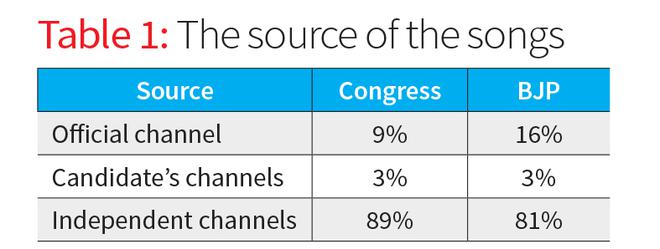
Quite a few songs posted by BJP supporters focus on India’s equation with China and Pakistan to evoke feelings of pride and patriotism among the listeners. While BJP songs focused less on criticising the Opposition and more on priding itself for the charismatic leadership and good governance of Prime Minister Narendra Modi, the Congress sought to gain public support by calling out the present government for looting the country and leaving the masses to live miserable lives. Such songs criticised the ruling government by calling them “destroyers of democracy’ and “gaddaro ki sarkar”.

Out of the total songs monitored and analysed, around 72% of BJP songs had religious connotations while only 10% of Congress songs revealed such indication (Table 3).
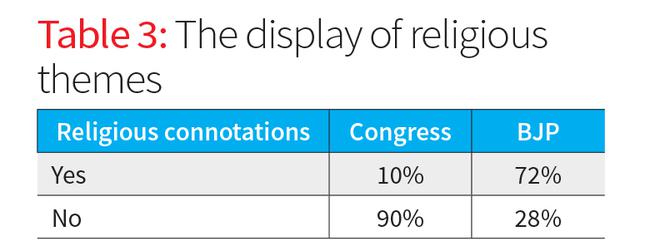
Almost every song focussed on the Ram Mandir wherein Mr. Modi has been hailed as a God-like figure who brought Ram back to his janambhoomi. Phrases like “Ayodhya ke baad, ab Mathura ki baari” have been repeatedly used. The lyrics, as well as visuals of the BJP songs, were found to be more leader-focused while Congress songs appeared to be more party-focused (Table 4).

The exclusive focus on Mr. Modi in campaign songs imply a deliberate strategy to capitalise on his image as a decisive leader.
Reading between the lines
The official handle of the BJP is spending more resources and effort on the content and duration of songs in comparison to the Congress. Almost all songs of the BJP have a clear message that India has been thriving under the leadership of PM Modi and that there is no one better fit to rule the country. Many songs have spoken about four major changes brought about by the Modi government — demonetisation, triple talaq, the removal of Article 370, and the building of the Ram Mandir. BJP songs evoke a strong sense of confidence wherein they and inevitability songs have repeatedly maintain that “Modi has already won the 2024 elections”. Congress songs, on the other hand, have focused more on the Bharat Jodo Yatra and its criticism of the BJP. While farmers are talked about in both BJP and Congress songs, the BJP displays a happy picture of them, benefiting from the schemes and policies of the government. On the other hand, Congress songs have tried to show the plight of farmers.
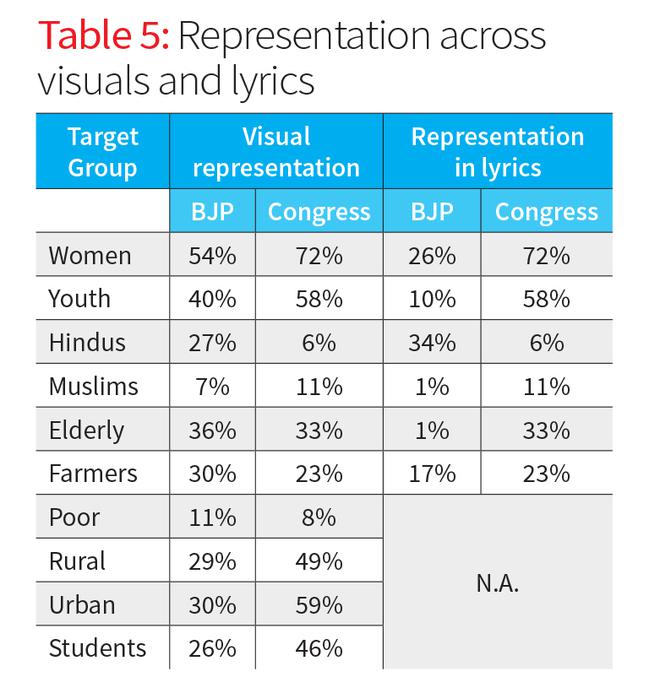
Interestingly, while the songs released by the BJP and Congress official handles are soothing and melodic, almost 80% of the songs released by party supporters of both parties incorporate DJ beats, seemingly to make them catchier and appealing to the youth.
On newspaper ad campaigns
Another study conducted by the CSDS-Lokniti delves into the print media advertisement campaigns of the BJP and Congress ahead of the Lok Sabha elections. The analysis spanned over a month, from March 20 to April 20, 2024, covering 11 dailies (Delhi edition) — six in English and five in Hindi. In total, 52 advertisements were published during this period, with 25 from the Congress and 27 from the BJP (Table 6).
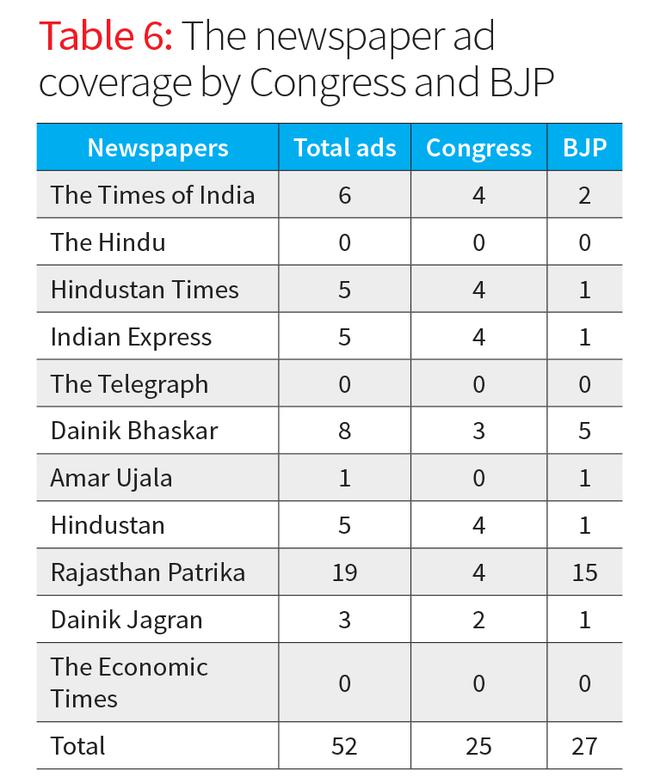
The findings aim to shed light on the strategic approaches and messaging employed by both parties in their print media campaigns. Most of the advertisements were in Hindi, regardless of the language of the newspaper in which they appeared. The ads not only focused on national parties but also spotlighted local politicians and party members (Table 7).
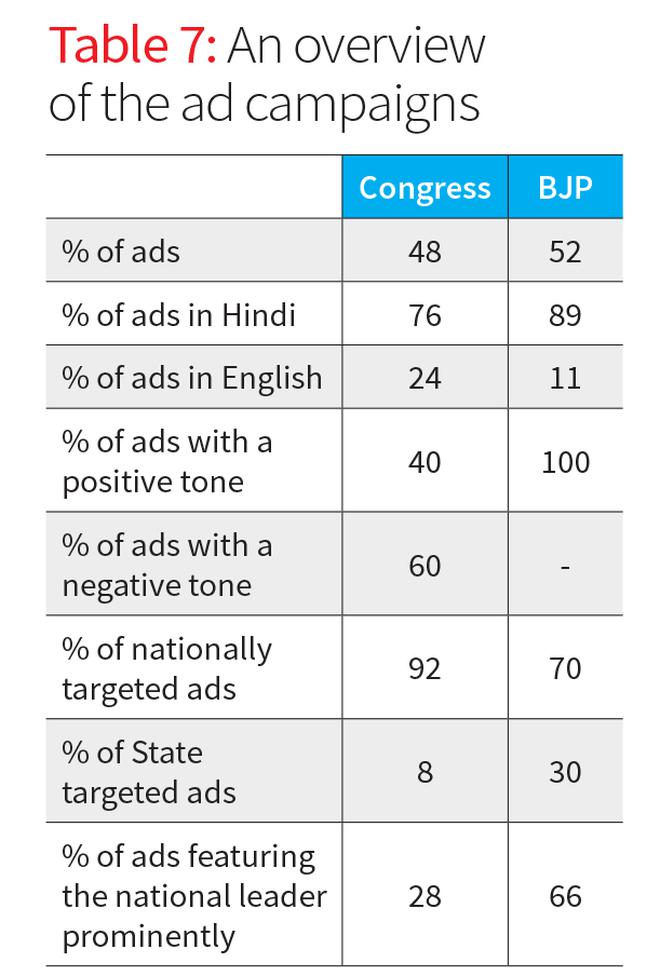
Most of the Congress ads, sponsored by the All India Congress Committee, are framed as ‘issued in the public interest’. These ads highlight the government’s perceived failures, targeting reservation, unemployment, farmers’ distress, and welfare schemes (Table 8).
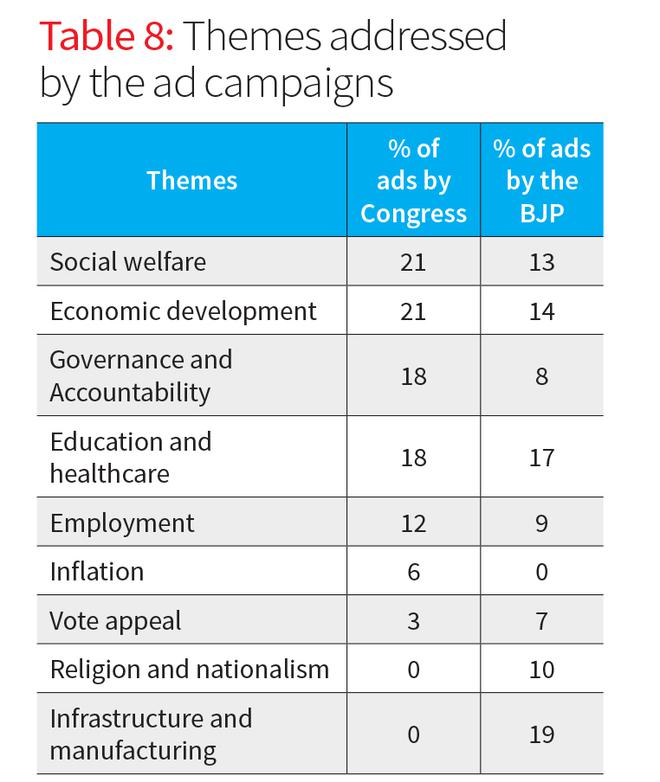
Instead of showcasing leaders — either national or State —the majority of these ads depict citizens from diverse backgrounds, including the youth, women, and farmers (Table 9).
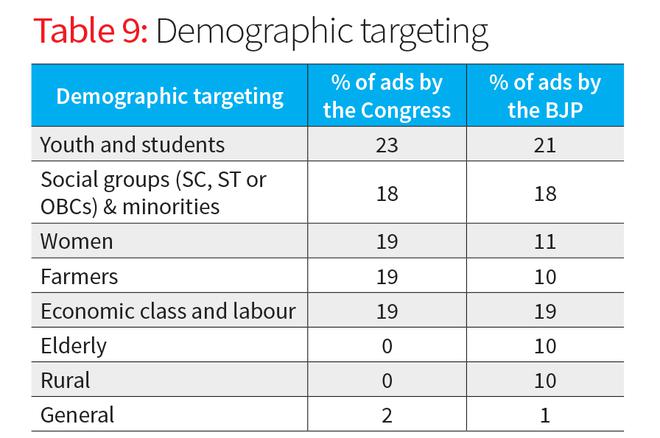
These citizens express their grievances or dissatisfaction with the current government’s policies. The ads reframe BJP’s well-known slogan, “Sab ka saath, sab ka vikaas,” into “Mere vikaas ka do hisaab”, to capture the public’s assertion for accountability.
Most Congress ads, even in their capacity as offensive attacks, fall short of effectively positioning the party for the upcoming election. They offer no alternative visions to the BJP’s policies. The ads also lack focus on the Congress’s manifesto, policies, or achievements. The overall tone remains negative, often targeting the ruling party rather than promoting their own vision by highlighting policy solutions. As the polling date approached, the INC’s “Nyay Yatra” campaign reached its culmination with the publishing of “Paanch Nyay Guarantee,” their manifesto advertisement. This ad, published only once during the study period, was the sole advertisement highlighting the Congress’s objectives.
BJP’s ad campaigns, on the other hand, focus on its policies and achievements, particularly highlighting the outcomes of its governance during the last 10 years in power. The ads prominently feature PM Modi, positioning him as the driving force behind all of the government’s successes. The ads also use eye-catching statistics to provide credence to their achievements. For example, the BJP’s ads showcases achievements such as the construction of homes for four crore families and lifting 25 crore citizens out of poverty. Furthermore, there’s a significant difference in the regional targeting of ads between the two parties. BJP focused more on localised campaigns, as observed in one Hindi daily, where they highlighted efforts made to solve local issues.
More focus on digital media
Print media clearly isn’t the focus of either the BJP or the Congress. While the BJP spent more than ₹17 crore posting over one lakh ads on Google during the period of this study, and the Congress spent more than ₹13 crore posting 2500+ ads, both parties together posted just 52 ads in national dailies from March 20 to April 20. Notably, the BJP published 14 advertisements between April 17 to April 19 while the Congress published just one. This is significant as these ads were published during the silent period before the first phase of polling on April 19.
The Congress adopts an attack- oriented strategy for its campaign, focusing on highlighting problems rather than presenting solutions. Unlike the BJP, it fails to offer a compelling narrative of a future under a Congress government. The Congress has refrained from using subjects like religion and nationalism to arouse emotions among the voters.
Sanjay Kumar is professor at CSDS, Aditi Singh is assistant professor at O.P. Jindal Global University, Vibha Attri is Research Associate at Lokniti-CSDS, Vandita Gupta and Naina Eve Gupta are researchers with Lokniti-CSDS.







